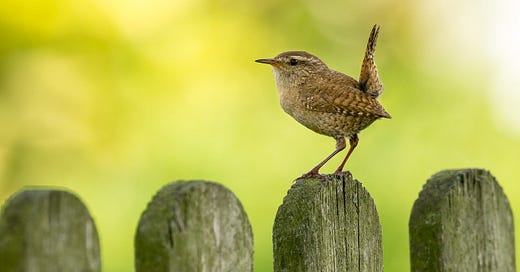You will probably hear it. But will you be able to see it?
The wren is one of our tiniest and yet loudest resident songbirds, and finds a home in nooks and crannies across the UK.
Its song is bright and consistent. It can go on blasting out that same sequence with incredible fidelity, hour after hour.
The strength and regularity of the song, with its penetrating trills, are the clearest giveaways.
It’s a good one to pick up through repeated exposure, because you can hear it all over the place - most urban parks, field edges and woodlands have their wrens, but windswept hillsides, coastal headlands, lakesides and marshes often have them too.
Another clue is that wrens seem to lack an ‘off’ button. They can be heard on bright winter days, and continuously from early spring, through summer and well into autumn.
Wrens are ground-huggers, and tend to sing from a low perch. This may be perfectly viewable from a low branch or fence post, but can easily be hidden out of sight.
And when not singing, they’re likely making their strong, stony ‘tchk!’ alarm notes, often giving away their presence in nearby cover.
Listen to the wren’s alarm call at xeno-canto
At times these notes cascade into an intolerant trill (about ten seconds into the recording above).
Among all bird calls, this noise from the wren may be the single most helpful clue to the presence of nearby trouble.
The trigger is often a cat or a person (perhaps you), but it could also be a fox, stoat or something else low to the ground that might otherwise pass you by.
Crevice dwelling
Their Latin name Troglodytes troglodytes (‘cave dweller’) refers to their knack of finding shelter in the stony crevices that most birds avoid, or perhaps just can’t fit into. This gives them purchase in places with less vegetation, such as cliffs and mountainsides, where other songbirds can be few and far between.
And while you rarely see more than one or two wrens together at one time, in harsh weather they may huddle together for warmth in the same roost.
The most remarkable account concerns over 60 birds piling into a nestbox in Norfolk one winter’s evening. Sounds cosy.
I can’t help but wonder whether there was a hole in the back of the box and they were pulling the biscuit factory trick like the mice in Bagpuss.
Next week: Chaffinch
There’s a new Shriek of the Week every Friday. If you know someone who might like a dose of birdsong in their inbox this year, please pass this along.
Find more birds by ear in 2023 with Birdsong Academy
The ten-week British Birdsong Essentials course begins 25 Feb - there are three places left (including low-cost options)
Upcoming Sussex walkshops - the next is at Stanmer Park near Brighton
Drop in to a free Up With The Birds dawn chorus call (beginning again 6.30am Sat 18 Feb 2023)
Shriek of the Week - paid version (for audio versions of each Shriek, a monthly live masterclass or supporters-only live birdsong call via Zoom, plus warm feelings).
Hope to see you there. Enjoy the birds.
~ Charlie
Credits:
Wren image by marliesplatvoet on Pixabay





